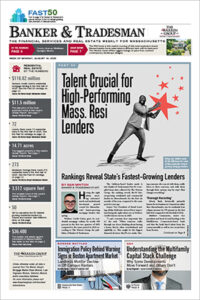
With expectations high for Federal Reserve rate cuts, lenders of all stripes are looking to see what commercial real estate borrowers they can land this fall. iStock illustration
Expected Federal Reserve interest rate cuts have Massachusetts bankers looking for ways to shave basis points off commercial real estate loan rates – and private lenders planning to defend market positions they grew as banks pulled back in 2022 and 2023.
By at least one measure, commercial real estate lending has already picked up at the national level this year.
The CBRE Lending Momentum Index, which tracks the pace of CBRE-originated commercial loan closings in the U.S., rose by 45 percent year-over-year in the second quarter. This increase came after a 6 percent decline from the first quarter of 2025, partially due to uncertainty over the then-new Trump administration’s economic plans.
Some of that was likely due to the One Big Beautiful Bill Act – President Donald Trump’s signature tax and policy bill passed over the summer – argued South Shore Bank Chief Commercial Lending Officer Stephen DiPrete.
“There’s been a lot of reassessing and resizing loan requests, and I do see some effects potentially from the new bill passed in Washington that may generate some activity as well,” he said. “Overall, we’re seeing a pretty steady wave of demand, mostly on new builds or expansion projects.”
As local banks look to win deals this fall, though, they’ll face expanded competition from private lenders that have expanded their footprint in the last two years.
According to CBRE, alternative lenders are taking the majority share of the lending pool across the country that’s not backed by Fannie Mae or Freddie Mac. The two mortgage giants are best known for buying residential loans, but also buy billions of dollars’ worth of multifamily debt every year – up to $146 billion in total this year, alone – and help power a significant portion of the Massachusetts multifamily development industry.
Debt Funds Stake Out Territory
Alternative lenders, including debt funds and mortgage REITs, led CBRE’s non-agency loan closings in the second quarter of 2025, capturing a 34 percent share. Debt funds drove much of this increase with lending volumes rising 89 percent quarter-over-quarter and 52 percent year-over-year.
The higher interest-rate environment of the last two years caused some banks pull back from the CRE market, said David Grossman, president of private CRE lender First Boston Capital Partners.
Fewer deals penciled and some bank executives were public about their belief that capital could be more effectively deployed elsewhere, like business and equipment lending. And federal regulators pressured many banks to reduce the concentration of commercial real estate loans on their balance sheets.
“The higher interest rate environment has resulted in fewer transactions. However, it has also resulted in a material pullback from conventional lenders and private lenders like First Boston have been able to fill that void,” Grossman said. “In addition, as banks have begun to charge higher rates in the last 2.5 years, the spread on the cost of our funds compared to banks has made the relative cost of private capital more compelling than it had been when banks were charging 3 [percent], 4 percent.”
While banks can take time to go through the loan approval process, alternative lenders fill a need in the market for speed and certainty of execution. Additionally, if a developer is looking for a short-term loan, it might need to look for options outside of a financial institution.
“Banks don’t like short-term loans. Banks have a lot of compliance to deal with. It’s very costly for banks to originate loans. It takes a long time to be put on the books,” RD Advisors managing partner Sean Kelly-Rand said. “We’re purposely built to do real estate lending so that makes us very quick, very efficient. I’m closing a loan before a bank has time to issue a term sheet.”
Rate Cuts, Year-End Rush Collide
While there is plenty of demand, interest rates continue to remain high. The effective federal funds rate has stood pat since December of 2024 and 10-year Treasury bond rates have hovered between 3 percent and 4 percent throughout 2025.
And many developers are hungry for debt, Kelly-Rand said.
“I think there’s quite a few developers now that are significantly hurting because they were not prepared for the interest rate rise. Once the interest rates rose, they were expecting them to fall very quickly. They thought it would be something very temporary. I would go out and point out quite the reverse,” he said. “I think there’s a lot of people that are hurting because they did not expect interest rates to go so high, and they did not expect that they would remain high for so long.”
If, as some financial commentators have predicted, the Federal Reserve cuts its benchmark short-term interest rate multiple times before the end of the year, said Cooperative Bank of Cape Cod CFO Eric Porter, could increase activity in the market. There is the potential for 75 basis points cuts combined throughout the end of the year, he added.
That will come on top of a traditional flurry of commercial lending activity that tends to take place towards the end of every year, Leader Bank Chief Lending Officer Matthew Pierce said.
“I’ve been doing this 25 years, but for some reason, in the fourth quarter of every year, there’s a fourth-quarter blitz, whereas there’s a huge uptick in volume requests, closings for the fourth quarter, and we’re already starting to see signs of that in the third quarter.”

Sam Minton
‘Aggressive Pricing’ on ‘A-Plus Deal’
With the reduction in rates built into their expectations, Pierce said, some banks are starting to become more aggressive, looking to snag deals with competitive pricing.
“We’re starting to see banks – including us – sharpening the pencil on deal pricing, maybe even thinner margins, or different pricing structures to do deals a little bit more aggressively, because we definitely saw an uptick in our competition, in pricing from our peer banks to win deals. There’s more deals out there that, I think, banks can be really picky. And on an A-plus deal, on really good credit, I’ve seen some very aggressive pricing out there that I didn’t see at all in the last few months.”
But while an interest rate cut could jumpstart some developments, it could also be a negative sign for how long any uptick in commercial real estate lending will last.
“Interest rate cuts are typically saying that we’re trying to spur activity, because maybe there’s other weaknesses,” South Shore Bank’s DiPrete said. “There’s higher unemployment that could affect multifamily housing, could affect rents, demand for products. Rate cuts don’t always come with just the upside. It sometimes is associated with a problem in the economy that might be as much of a factor as the interest rate environment.”






